Friday, March 27, 2009
Crabs feel and remember pain
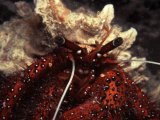 New research published by a Queen's University academic has shown that crabs not only suffer pain but that they retain a memory of it.
New research published by a Queen's University academic has shown that crabs not only suffer pain but that they retain a memory of it.The study, published in the journal Animal Behaviour, looked at the reactions of hermit crabs to small electric shocks. It was was carried out by Professor Bob Elwood and Mirjam Appel from the School of Biological Sciences at Queen's University Belfast.
Professor Elwood, who previously carried out a study showing that prawns endure pain, said his research highlights the need to investigate how crustaceans used in food industries are treated.
Hermit crabs have no shell of their own so inhabit other structures, usually empty mollusc shells. When the crab becomes to large for its current shell, it looks for another. When it finds a likely looking one, it will try it on. If the shell doesn't fit, or is too heavy, the crab returns to its old shell and continues it search. Where there is a large population of hermit crabs and a shortage of shells, the crab will accept a sub-standard home: maybe a cracked or uncomfortable shell. But in good conditions it will be very particular about the new shell it chooses.
During the research wires were attached to shells to deliver the small shocks to the abdomen of the some of the crabs within the shells.
The only crabs to get out of their shells were those which had received shocks, indicating that the experience is unpleasant for them.
Hermit crabs are known to prefer some species of shells to others and it was found that that they were more likely to come out of the shells they least preferred. This shows that central neuronal processing occurs rather than the response merely being a reflex. They traded-off between keeping a good shell and acceptance of the shock.
Crabs that had been shocked but had remained in their shell appeared to remember the experience of the shock because they quickly moved towards the new shell, investigated it briefly and were more likely to change to the new shell compared to those that had not been shocked.
Professor Elwood said: “There has been a long debate about whether crustaceans including crabs, prawns and lobsters feel pain. “We know from previous research that they can detect harmful stimuli and withdraw from the source of the stimuli but that could be a simple reflex without the inner ‘feeling’ of unpleasantness that we associate with pain.
“This research demonstrates that it is not a simple reflex but that crabs trade-off their need for a quality shell with the need to avoid the harmful stimulus.
“Such trade-offs are seen in vertebrates in which the response to pain is controlled with respect to other requirements.
“Humans, for example, may hold on a hot plate that contains food whereas they may drop an empty plate, showing that we take into account differing motivational requirements when responding to pain.
“Trade-offs of this type have not been previously demonstrated in crustaceans. The results are consistent with the idea of pain being experienced by these animals.”
Professor Elwood says that in contrast to mammals, little protection is given to the millions of crustaceans that are used in the fishing and food industries each day. He added "Millions of crustacean are caught or reared in aquaculture for the food industry. There is no protection for these animals (with the possible exception of certain states in Australia) as the presumption is that they cannot experience pain.
Journal Reference:
Robert W. Elwood and Mirjam Appel, Pain experience in hermit crabs?, Animal Behaviour (2009), doi:10.1016/j.anbehav.2009.01.028.
-
What do you think of this news item? Join a discussion.
Labels: marine biology, research, SCUBA News
Thursday, March 26, 2009
Underwater photography competition: enter now
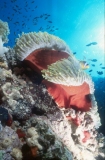 2009 is the 31st year of the International Festival of Underwater Photography, Films and Children's Artwork.
2009 is the 31st year of the International Festival of Underwater Photography, Films and Children's Artwork. The festival is open to both amateurs and professionals. You may enter by uploading photographs at http://www.paftachov.cz/en/www/. The deadline for accepting the works April 22nd 2009. The photographic categories include: wide-angle image without a diver; wide-angle image with a diver; macro image and water animal image.
The festival started in 1979. In the beginning it was a modest 16mm and 8 mm films competition, later upgraded with photographs.
As the time went by, categories expanded with slides, videos, and children's art works being added.
At first all competition works were assessed only by the audience. Then in 1994, professional juries were introduced.
In addition to local authors, participants in the come from many countries including Australia, Belgium, Egypt, Finland, France, Italy, Canada, Yugoslavia, Tunisia, Turkey, Ukraine, USA and Great Britain.
The festival is now an international event organised under the auspices of CMAS, the World Underwater Federation which is one of the oldest dive organisations in the world.
The originally one-day event has become a four-day event with a lot of space for discussions, friendships, offering divers plenty of experiences and issues to be assessed. Anyone can join this festival, which is aiming to present results of diver's works in many forms, the artistic in particular.
The festival takes place in Tachov, Czech Republic, from 21st to 24th May 2009.
Further reading:
http://www.paftachov.cz/en/www/
--
What do you think of this news item? Join a discussion.
Labels: photography, SCUBA diving, SCUBA News, SCUBA Travel
Tuesday, March 24, 2009
Deep-sea corals live thousands of years
 Deep-sea corals are found on hard substrates on seamounts and continental margins worldwide at depths of 300 to around 3000 m. Deep-sea coral communities are hotspots of living things, both in terms of numbers and diversity of species. They provide critical habitat for fish and invertebrates.
Deep-sea corals are found on hard substrates on seamounts and continental margins worldwide at depths of 300 to around 3000 m. Deep-sea coral communities are hotspots of living things, both in terms of numbers and diversity of species. They provide critical habitat for fish and invertebrates. According to research published this week in the Proceedings of the National Academy of Sciences, newly applied radiocarbon dating of the deep water corals Gerardia and Leiopathes species show that their growth rates are extremely low, and that individual colonies live for thousands of years. The longest-lived specimens were Leiopathes species (black corals) at 4265 years old.
The coral specimens were collected with submersibles off the coast of Hawaii. The authors measured the age of the corals' proteinaceous skeleton and found that the corals grew much more slowly than previous dating techniques had shown.
The management and conservation of deep-sea coral communities is challenged by their commercial harvest for the jewellery trade and damage caused by deep-water fishing practices.
The scientists conclude that in light of the corals' unusual longevity, we need to better understand their ecology and relationship with other bottom-dwelling creatures before forming a coherent international conservation strategy for these important deep-sea habitat-forming species.
Black Corals
Leiopathes black corals have a dark skeleton, after which they are named. The black skeleton forms irregularly branching, tree-like structures. Gorgonian-like, the skeleton is covered with polyps. Leiopathes corals are listed on Appendix II of the Convention on International Trade in Endangered Species (CITES), which means that they are not necessarily now threatened with extinction now but that may become so unless trade is closely controlled. Gerardia species are sometimes known as False Black Corals. Not all of these are deep sea: colonies are found in the Mediterranean between 50 and 80 m.
Journal References:
E. Brendan Roark, Thomas P. Guilderson, Robert B. Dunbar, Stewart J. Fallon, and David A. Mucciarone. Extreme longevity in proteinaceous deep-sea corals. PNAS 2009 : 0810875106v1-pnas.0810875106.
E. Brendan Roark, Thomas P. Guilderson, Robert B. Dunbar and B. Lynn Ingram. Radiocarbon-based ages and growth rates of
Hawaiian deep-sea corals. MARINE ECOLOGY PROGRESS SERIES, Vol. 327: 1–14, 2006
-
What do you think of this news item? Join a discussion.
Labels: coral, research, SCUBA News
Fins evolved from gills, research suggests
Andrew Gillis, lead author of the paper, says "This new finding is consistent with an old theory, often discounted in science textbooks, that fins and (later) limbs evolved from the gills of an extinct vertebrate. A dearth of fossils prevents us from definitely concluding that fins evolved from gills. Nevertheless, this research shows that the genetic architecture of gills, fins and limbs is the same.”
The research builds on the breakthrough discovery of the fossil Tiktaalik, a "fish with legs," by Neil Shubin and his colleagues in 2006.
According to the researchers, the genetic circuitry that patterns paired appendages (arms, legs and fins) has a deep evolutionary origin that actually predates the origin of paired appendages themselves.
They found that treating a skate embryo (a relative of the shark) with Vitamin A's retinoic acid, affected the gill arch skeleton in the same way as an arm, leg or fin skeleton.
The deep structural, functional and regulatory similarities between paired appendages and developing gill rays, as well as the antiquity of gills relative to paired appendages, suggest that the signalling network that is induced by retinoic acid had a patterning function in gills before the origin of vertebrate arms, legs or fins, the research concludes. And this function has been retained in the gill rays of living cartilaginous fishes like skates, rays and sharks.
-
What do you think of this news item? Join a discussion.
Labels: research, SCUBA News
Tuesday, March 17, 2009
97% of Divers disturb seabed: Males worst offenders
 Most SCUBA divers disturb the seabed, Spanish researchers say. A study published in the ICES Journal of Marine Science found that nearly 97% of divers in marine protected areas (MPAs) made contact with the bottom. Inexperienced, male divers carrying a camera or torch were the worst offenders.
Most SCUBA divers disturb the seabed, Spanish researchers say. A study published in the ICES Journal of Marine Science found that nearly 97% of divers in marine protected areas (MPAs) made contact with the bottom. Inexperienced, male divers carrying a camera or torch were the worst offenders.Creating a marine protected area tends to increase diving in that vicinity. Scientists from the University of Alicante studied the behaviour of divers in marine protected areas, the effects of diving on the natural environment and the characteristics that influence diver behaviour. They found that impacts caused by recreational scuba activity vary widely among different divers.
The scientists followed a total of 181 recreational divers in Mediterranean MPAs, recording the contacts they made with the seabed and the effects produced. They also made notes on the features of the dive. Their observations revealed that 175 of the divers observed (96.7%) made at least one contact with the seabed. Flapping was the most frequent type of contact, and the main damage by this action was to raise sediment.
Contact with the seabed was greater for males than for females, inexperienced divers than for experienced divers, camera or dive light users than for non-users, and divers unaccompanied by a dive leader or who had not been briefed about avoiding seabed contact before undertaking a dive than for accompanied or briefed divers.
The research team hopes that a greater understanding of the causes of harmful behaviour may be useful for stricter management, reducing diving damage and assuring the sustainability of diving in marine protected areas.
Journal Reference:
Luna, B., Valle Pérez, C., and Sánchez-Lizaso, J. L. 2009. Benthic impacts of recreational divers in a Mediterranean Marine Protected Area. – ICES Journal of Marine Science, 66: 000–000.
--
What do you think of this news item? Join a discussion.
Labels: Mediterranean, research, SCUBA diving, SCUBA News, SCUBA Travel
Monday, March 16, 2009
BSAC Photographic Competition 2009
 To run from March to the end of November, the British Sub-Aqua Club are now inviting monthly submissions for their 2009 photography competition. Each month between now and November, BSAC will select between 9 and 15 shots to go forward to the grand final.
To run from March to the end of November, the British Sub-Aqua Club are now inviting monthly submissions for their 2009 photography competition. Each month between now and November, BSAC will select between 9 and 15 shots to go forward to the grand final.There are three entry classes: Open, Open newcomer and BSAC newcomer. The newcomer class is for people who have never won a photography competition or sold their work.
To enter fill in the BSAC entry form and upload your photos. For each photo entered you must then give: a caption or description of the photo; the location and the approximate date on which the photo was taken. Photos must not exceed 460 pixels in width.
Prizes include holidays and underwater camera vouchers.
--
What do you think of this news item? Join a discussion.
Labels: photography
Wednesday, March 11, 2009
Survey Reveals Top 10 Dive Sites in Europe
- The Zenobia, Cyprus
The pristine wreck of a huge ferry. Lying on its port side, the wreck starts at about 15 m and descends to 42 m. Fabulous dive. Possibly the best shipwreck dive in the world in recreational depths. 20 m plus visibility and some great swim-throughs. Needs several dives to see anything like all of it.
- Blue Hole, Gozo
A beautiful sharp drop off into the blue hole with what seems like limitless visibility and literally feels like you are on the very edge of the world. A most extraordinary dive.
- Cirkewwa, Malta
Features the wreck of the Rozi MV as well as stunning underwater topography. Visibility is very good and there iss ea life in abundance: barracuda, morays, octopus, cuttlefish and even dolphins.
- Booroo, Isle of Man
The Burroo, with its extremely diverse and plentiful marine life offers a truly magnificent dive. In fact, in areas exposed to the fast flowing current, it is something of a challenge to find a single square centimetre of bare bedrock, so abundant is the life here.
- Blockship Tabarka, Scapa Flow, Scotland
This shallow 18 m dive is a real beauty. One of the block ships scuttled to prevent submarine attack during WW2. Covered in life, a beautiful place. Worth the trip and the one of surprises of Scapa.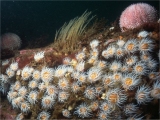
- Diamond Rocks, Kilkee, Ireland
Claimed to by on a par with the famous Yongala. It is a cold water dive off Ireland's west coast. The bay is fairly sheltered and is teaming with life. The terrain is full of rocks and gullies and the water is really clear.
- Eddystone Reef, England
12 miles off Plymouth, England. The reef is from 8 to 60 m. Encrusted with jewel anemones and with the remains of ancient wrecks, including a large 17th century anchor. Stunning.
- Secca della Columbara, Italy
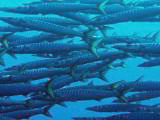 One of the best dives in the Mediterranean. It features a steep, beautifully-decorated, wall; large shoal of barracuda; grouper; giant amberjacks and a wreck. The wreck is a 74 m ship which was carrying slabs of marble. It sank in 2005 and rests at 20 m in two parts.
One of the best dives in the Mediterranean. It features a steep, beautifully-decorated, wall; large shoal of barracuda; grouper; giant amberjacks and a wreck. The wreck is a 74 m ship which was carrying slabs of marble. It sank in 2005 and rests at 20 m in two parts.
- Fanore, Ireland
Shore dive in crystal clear Atlantic water with abundant fish.
- Chios island, Greece
Small undersea caves and paths between impressive rocks, colourful reefs and vertical walls.
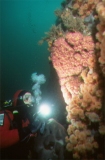
What do you think of this news item? Join a discussion.
Labels: Europe, Greece, Ireland, Italy, Malta and Gozo, Mediterranean, SCUBA diving, SCUBA Travel, UK
Tuesday, March 03, 2009
Loss of small fish may be starving the oceans
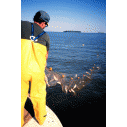 According to a report by Oceana, there is widespread malnutrition in fish, marine mammals and seabirds because of the global depletion of the small fish they need to survive. These "prey fish" underpin marine food webs and are being steadily exhausted by heavy fishing, increasing demand for aquaculture feed, and climate change.
According to a report by Oceana, there is widespread malnutrition in fish, marine mammals and seabirds because of the global depletion of the small fish they need to survive. These "prey fish" underpin marine food webs and are being steadily exhausted by heavy fishing, increasing demand for aquaculture feed, and climate change. The report finds that 7 of the top 10 fisheries in the world target prey fish. These fisheries have emerged as populations of bigger fish have become overexploited and depleted. The report concludes that the impacts of fishing activity over the past decades has been so great that the nearly all prey fisheries now cannot withstand increased fishing pressure. It also finds that aquaculture is increasingly the driver behind overfishing of prey fish, as salmon, tuna and other carnivorous farmed fish become the fastest growing seafood products in the world. Changing ocean temperatures and currents caused by climate change also make prey fish populations more vulnerable.
Ricardo Aguilar, Director of Investigation for Oceana Europe, says: "When it comes to managing a fishery or talking about overexploitation, we often forget that the disappearance of one species due to overfishing has severe impact on stocks of other species. A clear example is bluefin tuna, which disappeared from Norwegian coasts after herring populations collapsed. Nowadays the absurdity is that both tuna and its prey are overexploited in order to feed these very tunas in fattening cages".
Oceana conclude that more responsible management is needed to prevent predators from going hungry. It proposes a series of measures including a moratorium on new fisheries targeting prey species, conservative catch limits for existing fisheries, first priority for the needs of ocean predators and stopping fishing for prey in predator breeding hotspots.
Further Reading: Hungry Oceans Report
-
What do you think of this news item? Join a discussion.
Labels: environment, fish, SCUBA News